'I switched HIIT for weights for 6 weeks, here are my results'
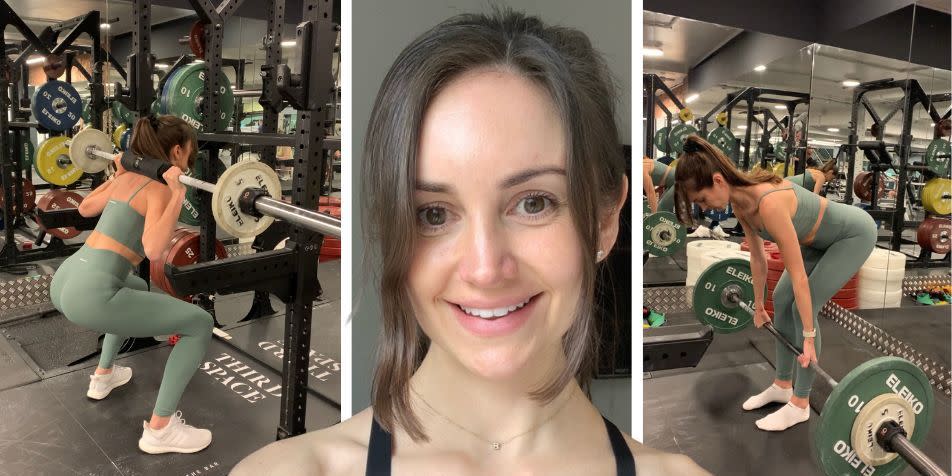
For decades, the rhetoric around women’s weightlifting was both misleading and intimidating. We were led to believe lifting weights would mean becoming ‘bulky’ and that that was something we should fear, while the male-dominated weights spaces in gyms meant women felt weightlifting wasn't for them. I fell victim to both these things.
From the age of 18, when I started going to the gym and taking fitness more seriously, up until around 23, I barely picked up a single dumbbell. Instead, a 30-minute run with the occasional 10-minute ab workout tacked onto the end, or an intense 30-minute HIIT routine, would count as a solid gym session.
I was 25 when I first incorporated more strength training; an average week would involve one reformer Pilates class, one vinyasa yoga class, one (fairly light) free weights session and one run. That women’s weightlifting is now more widely ‘accepted’ (almost 1k of you search for weightlifting for women advice every month) surely played a part when I first gave my routine a shake-up, but with age, I’ve also come to realise that the way we exercise shouldn’t be dictated by society.
'Strong not skinny' might be the new to-do term, but it still enforces an aesthetic ideal that women are expected to adhere to, and that’s not why I wanted to try ramping up my weightlifting. It was for the never-ending list of benefits. Studies show that after the age of 30, you may lose 3-8% of muscle mass per decade, and an additional study from Copenhagen University Hospital in 2019 found that weightlifting may offer more protection against heart disease than cardio exercise does. I could go on.
And so my mission began. Last year, when I was 30 and with the help of the legend that is Loui Fazakerley, a PT at Third Space Soho, I embarked on a six-week weightlifting challenge, including six weekly personal training sessions with Fazakerley, to find out just how effective weightlifting is for both the mental and physical health of women and to share all of the tips and tricks I pick up along the way, from form and technique to how to conserve your energy.
My weekly weightlifting routine
Before we jump into it, here’s a breakdown of exactly how an average week looked during this six-week period. I’m another level of competitive (Christmas games are a turbulent time) and as much as I wanted to give it my all, I didn’t want to overdo it on the weightlifting front, so I committed to two sessions per week, alongside one reformer Pilates and one yoga session – both of which I adore and were always set to be mainstays.
My lower body is my weakest area, so I chose to focus on this during my PT sessions with Fazakerley. I then did one upper body and core weights session at my local David Lloyd gym.
Monday: Rest
Tuesday: Upper-body and core weights workout
Wednesday: Rest
Thursday: Lower-body weights workout
Friday: Yoga
Saturday: Rest
Sunday: Reformer Pilates
Week 1
Muscle growth (and strength) was my main goal, so Fazakerley and I agreed on doing a body composition scan. It tells me everything from how much muscle I have in each arm (very handy for working on imbalances – apparently, I have a lot more muscle in my left than my right), to how much water weight I was carrying.
It was interesting, but what I will say is that I wanted to use my intuition as the main indicator of my progress, as opposed to the numbers on a scale. Did I feel physically stronger? How confident did I feel as I tried lifting heavier? We only did a scan twice, at the start of week one and the end of week six, to note a difference in total muscle mass, and this wasn’t a necessity – Fazakerley asked if I wanted to use it so that he could recommend specific exercises and/or nutrition advice.
Then came my first session. I’ll admit I was apprehensive, but I made sure Fazakerley was aware of my (lack of) experience and we began with the basics. Since my programme with Fazakerley had a lower body focus (which I then bolstered with upper body sessions of my own), we focussed on nailing the compound lower body moves that would make up the base of our sessions: squats and Romanian deadlifts, as well as hip thrusts. Read on to find out everything he taught me. Spoiler: there’s a lot.
Week 2
By the end of my second weightlifting session with Fazakerley, it’s clear to me why so many women enjoy it. I feel a huge sense of accomplishment, and I’m surprised by how much I can lift (session two is the first time we attempt adding any load - session one was purely form-focussed). TBH, I think a lot of this comes down to fear. I’d never felt confident enough to see how heavy I can lift when I’m alone, in case I injure myself (or someone else - you never know), so having Fazakerley with me was my comfort blanket.
I’m well aware a PT isn’t accessible to everyone, but going to the gym with a friend, or asking a PT to spot you could be what you need to get going. You’re capable of more than you think, and the first step is always the hardest.
Opti Dumbbell Tree Set
Neoprene Dumbbell Pair of 1kg
Umi. By Amazon Dumbbells - Pair of 3kg
Women's Health Dumbbells - Pair of 4kg
Week 3
Given I was taking three rest days per week and following a workout split structure (more on this below), week three seemed to be somewhat of an anomaly. Come my session with Fazakerley, I felt weaker than ever. I could barely do one set of squats, and I felt as though I could eat for England.
Chances are this was just my body adjusting to its new way of life (and a way of life it definitely will be), but, naturally, it did make me question my new routine. Was I overdoing it? Was I eating enough? As a yogi and Pilates girl, maybe I wasn’t cut out for weightlifting? But Fazakerley assures me this is all part of the journey – nothing worth having comes easy, as they say. And so I persist.
Week 4
Though I’d say I’m stronger in my upper body (credit to the 4 million downward dogs I’ve done in my time), I’ve never really enjoyed doing dedicated arm or shoulder workouts since I've always preferred a super sweaty session which I could never get from these, but by week four I start to really look forward to them. I reckon this is mainly due to the fact the exercises made a welcome difference to the norm (I could count on one hand the number of arm exercises I ever included in my former full-body sessions), and I’m here for it.
As for my lower body sessions, week four was a turning point. I lifted heavier than ever before, and with my usual yoga class cancelled, I even added in a second leg and glutes workout of my own (incorporating different exercises to those that Fazakerley and I did together, so as to avoid fatigue or injury). Going it alone taught me something else.
One of the reasons I love yoga and running is that they allow me to totally zone out; they’re my form of meditation. I never imagined weightlifting could do this for me since there’s so much to think about, but by now, I’d become familiar enough with it that I managed to switch off. Of course, I still had to think about my form and technique, but running through a checklist of cues in my mind became like a mantra. I never once thought about any outside worries I had.
Week 5
Let’s just say my journey was not a linear one. My progress ebbed and flowed like there was no tomorrow, and week five was a low. I felt exhausted (not COVID), and so I honoured my body by cutting down to two workouts: one lower body workout with Fazakerley and one 30-minute yoga session. I also could. Not. Stop. Eating. Again, I took this as a sign I needed to slow down and recover, so that’s what I did. I’d posit that the post-heatwave dip may have also played a part; we’d gone from glorious sunshine in week four of my challenge, to grey skies, which likely made me feel more fatigued.
Tank Bra - Powder Blue
Ultimate Leggings - Powder Blue
Ultimate Leggings - Sea Green
Tank Bra - Sea Green
Week 6
While I'd definitely enjoyed the process before now, it was only on the final week that I really started to feel everything fall into place. I'd never struggled with sleep, but I was now guaranteed at least a solid 8 hours, and I'd got used to eating more and, specifically, more protein (both of which I'll talk about more in a mo), rather than a) forgetting to eat often enough or b) feeling super bloated and unable to consume any more. In turn, by my final session with Fazakerley, my body felt ready to go heavier, so I braved it and managed three sets of my heaviest squats, RDLs and hip thrusts to date.
With this being my last chance for a session with Fazakerley, I was also keen to get his words of wisdom on any lower body exercises we'd yet to try. He recommended back extensions and kettlebell swings - remember to squeeze your glutes and avoid overextending your back at the top of each movement and you're halfway there.
Weight lifting for women tips
Form tips
How to improve grip strength
One of the biggest issues for me was my measly grip. At the start, I’d barely manage one set of Romanian deadlifts before my hands would start cramping, so I was keen to get some pointers from Fazakerley on how to keep it in check. To note, these are all tips and tricks that I applied when doing barbell Romanian deadlifts.
1.Use a mixed grip
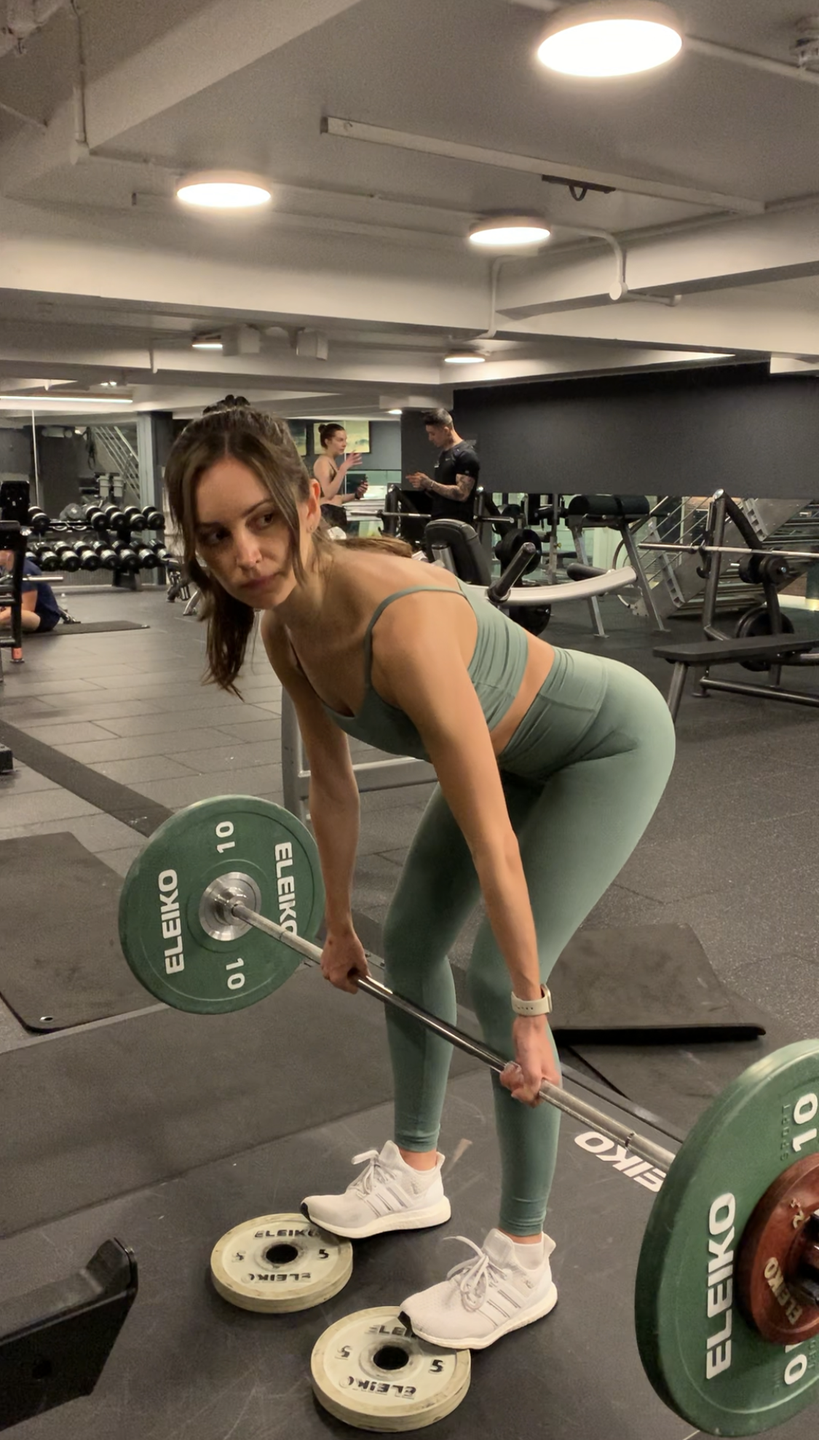
The most game-changing thing for me was using a mixed grip – one overhand and one underhand. I’d start with both overhand (palms facing in towards the bar) so that I could ‘gradually improve the strength of my forearms in this position’, as advised by Fazakerley, but as my strength weakened and I started to lose mind-muscle connection with my hamstrings and glutes (where it should have been during barbell Romanian deadlifts) as I was forced to focus on keeping the bar in my hands, I’d switch to alternate grips. This was usually after two sets of Romanian deadlifts.
I was worried this might be a bit of a cop out, but Fazakerley tells me that, in fact, using a mixed grip can be beneficial as it ‘trains every area of your forearms, as opposed to just the front with an overhand grip’.
2. Use a lighter barbell
If it’s a barbell you’re using, an easy trick is to use a lighter one. ‘The lighter they are, the thinner they are, so they’ll be easier to grip,’ Fazakerley tells me. Simple.
3. Use lifting straps or chalk
Once seen as the preserve of the pros, lifting straps and hand chalk are anything but. Admittedly, I didn’t try either (purely because chalk isn’t available at my home gym, and after every PT session with Fazakerley I was due back in the office where chalky hands weren’t exactly appropriate/convenient, and I don’t own lifting straps), but Fazakerley is a big fan. ‘Wrap the lifting straps around your barbell or kettlebell if you struggle with grip strength, but try not to rely on them too much – always do one or two sets without, and use them to help you reach your max potential,’ he says.
How to improve range of motion
1.Always perform mobility exercises before weightlifting
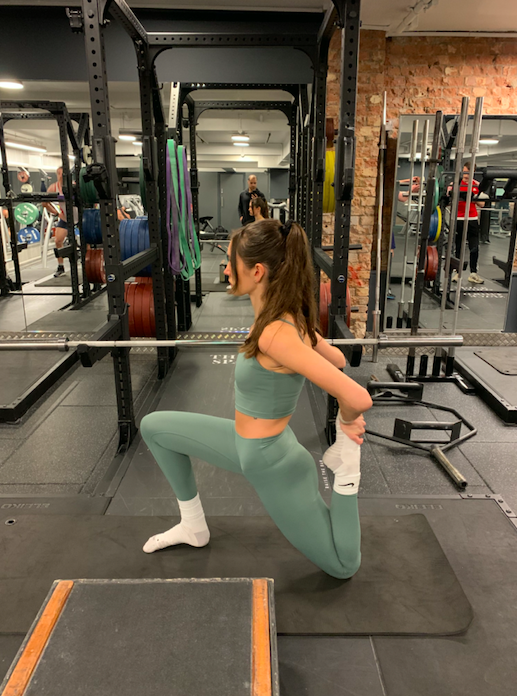
Without fail, before every weightlifting session (both with my PT and alone), I did a five-minute mobility warm-up. Fazakerley tells me that the most ideal exercises you do should be ones that mimic the exercises you’re about to do, to ‘encourage blood flow to the muscles you’re about to use’. For example, if my workout involved squats, I always performed 15 bodyweight squats during my warm-up.
Here are five exercises I performed before every lower body weightlifting workout:
Inchworms
Lunge + World’s greatest stretch
Hip flexors stretch
Deep squat with bottom hold
Side lunge
2. Elevate your heels on weight plates when doing squats
Turns out I’ve got pretty good ankle mobility, so this wasn’t always a necessity for me, but if you find that you can only go so low when squatting because your ankles feel tight, placing your heels on the edge of a weight plate means the front of your ankles won’t be so compressed, and so you’ll be able to increase your range of motion.
3. Elevate your toes on weight plates when doing deadlifts
Similarly, lifting your toes onto weight plates when deadlifting will enable you to get a deeper stretch in your hamstrings and glutes, since it ‘forces you to sit back into your hips, as opposed to leaning forward,’ Fazakerley explains.
4. Use a safety bar when squatting
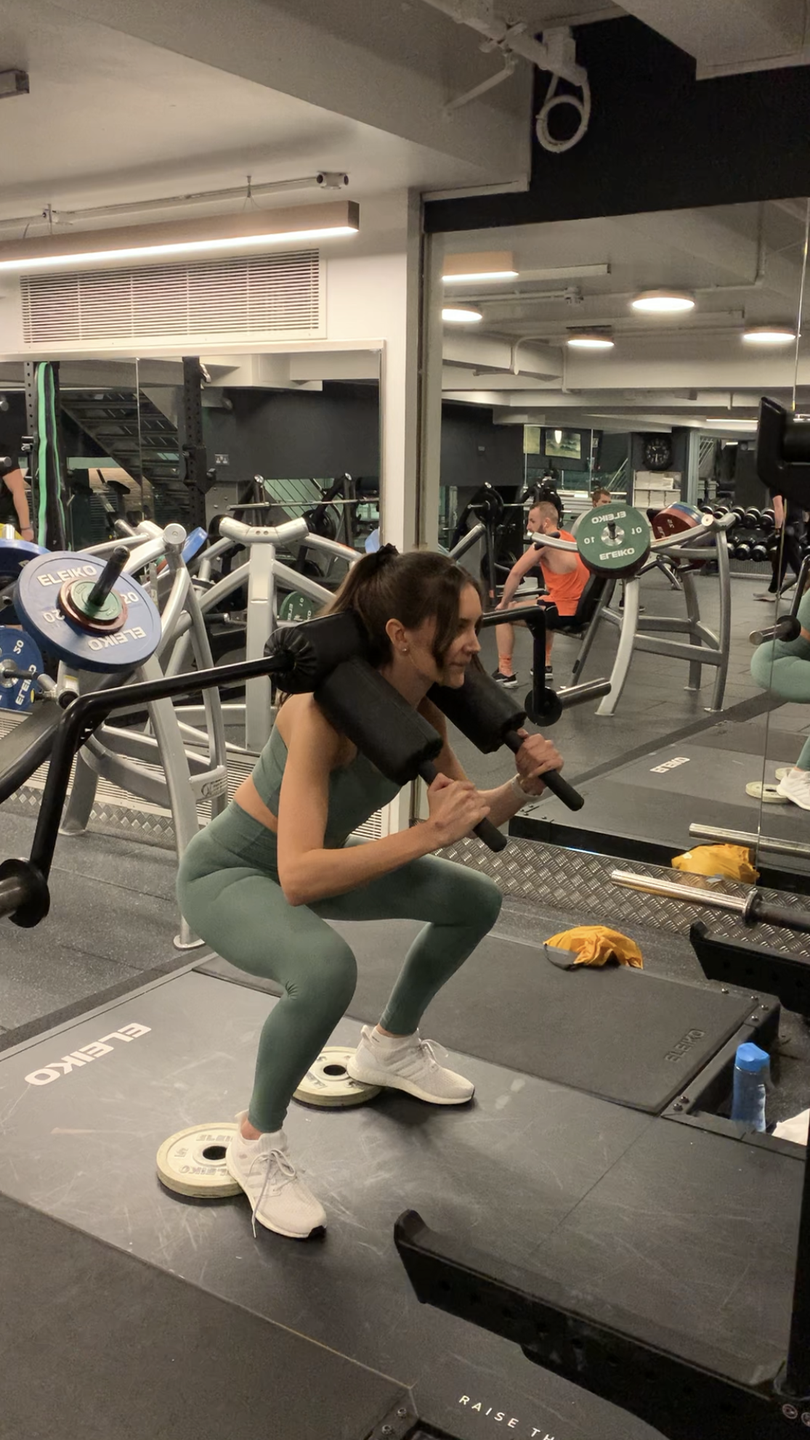
Anyone who struggles with shoulder mobility could benefit from using a safety bar when doing barbell squats. It’s a type of barbell that has handles positioned in line with your shoulders, out in front of you. ‘Holding onto the purpose-built handles means you don’t need as much mobility in your shoulders that is required to reach back to the barbell with a traditional grip, since the handles are out in front of you,’ says Fazakerley. A safety bar also typically features cushioning around your shoulders which can make it more comfortable.
5. Lift lighter to hit a full range of motion
The heavier the weights you use, the less likely you are to achieve a full range of motion, and the less likely you are to activate the correct muscles. This was certainly true for me. I’d get much more depth in my squat if I had a load I felt both comfortable and confident with. To prove how much I was missing out on if I went too heavy, Fazakerley set up the barbell hooks at the lowest point he'd seen me reach without any load, and tasked me with touching these hooks at either side of my barbell when it was loaded up with weight. Needless to say, I did not succeed. See me unable to finish the rep:
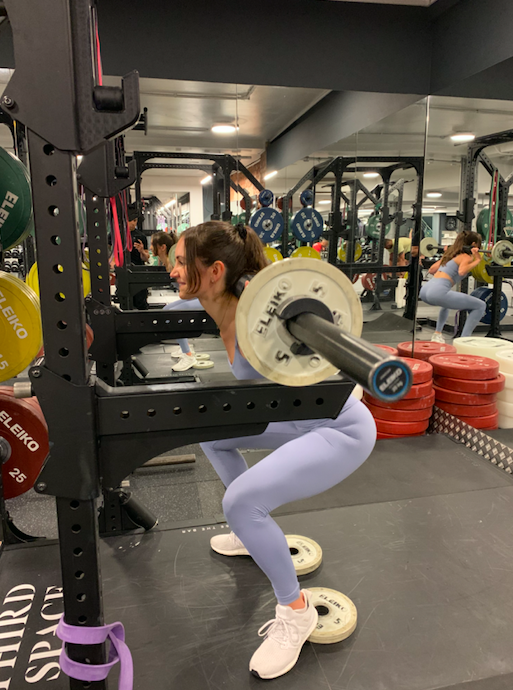
There’s no use in trying to lift heavier if it means you’re not executing the exercise to your full potential – you’ll see much bigger gains if you start light and add more weight incrementally (a process known as progressive overload), in a way that means you won’t compromise on form or ROM (range of motion).
General tips
1.Try different exercise variations to find what works for you
It’s safe to say barbell back squats are by far my weakest exercise. No matter how much I practiced, I hardly saw any progress over the weeks and I started to dread doing them. So, Fazakerley proposed front squats. Lots of women (and men) find them easier since holding the barbell in front of you 'forces you to keep your torso upright, meaning you’re more likely to maintain correct form', so says Fazakerley.
There’s also a variety of grip/hand positions you can try: the traditional front rack with your elbows straight forward and fingers tucked under the bar on your shoulders, the cross-grip front rack with your arms crossed over one another, or the zombie arm position, with both arms straight out in front and the barbell balancing on your shoulders. A cross-grip felt the most natural and comfortable for me.
2. Take your shoes off to improve balance
You know how some Olympic weightlifters wear trainers with flat soles? A lot of that is in aid of balance. I made a rookie mistake in wearing my usual Adidas UltraBoost running trainers to most sessions, and often felt wobbly when performing any kind of standing strength exercises, so Fazakerley recommended I take them off. As with most things, this is personal preference – you may well find you’d rather have the grip from the bottom of your shoes – but for me, taking my shoes off helped me feel more stable.
Ultraboost 5 DNA Running Lifestyle Shoes
3. When setting up for hip thrusts, position your barbell on top of two weight plates at either side
Anyone who does hip thrusts will resonate with the slog that is setting up. Ideally, you’ll be able to use a hip thrust machine to save you the hassle (I always opt for this as opposed to a traditional barbell set-up against a bench - handily, Third Space has one), but if you don’t have access to one, here’s a handy tip: place either end of your barbell, where the weights are, on top of weight plates at either side of your hips. Then, when it comes to finishing your sets, you can roll the barbell off and easily get out from underneath.
Progress tips
If you’ve got a strength goal in mind like I did, Fazakerley shared some game-changing pointers that I’d never even considered. As mentioned, I focussed on building lower body strength, but some of these are general principles that can be applied to all exercises. Take note.
1.Increase time under tension
Fazakerley tells me that while doing more sets or reps could help you hit your goals as you ‘damage your muscles more and therefore encourage more muscle growth’, time under tension can be a solid alternative strategy. For me, I’m not keen on the idea of doing more rounds of the same exercise as I can get bored easily, so Fazakerley implemented ‘one and a half reps’. Take hip thrusts. I’d execute one full thrust, then come halfway down and push back up again. It burns, but it works.
2. Know that some exercises are more effective than others for muscle growth
Each exercise has its own benefits, but Fazakerley shares a handy formula for mainlining muscle hypertrophy (a.k.a. muscle growth): stretch + load. ‘By combining a stretch with the stress of a weight, you’re doing more damage to your muscles at once,’ Fazakerley tells me.
He adds that a Romanian deadlift is ideal for this, since you stretch your hamstrings on the eccentric (downward) motion, as well as being under load. Hip thrusts, meanwhile, don’t necessarily hit the stretch element. This threw me since I always feel my glutes working during hip thrusts, while it seems harder to wake them up when doing Romanian deadlifts, but Fazakerley assures me this isn’t necessarily a sign that you’re doing the most damage (or therefore promoting the most muscle growth).
3. The slightest of form adjustments could make a big difference
Before my six-week challenge began, I would've said I was pretty well-versed in form, but how wrong I was. In reality, I only knew the surface-level stuff, and had no idea how significant such tiny position changes could be for targeting the correct muscles. Without getting too technical, I’ve broken down Fazakerley top tips per exercise, in as simple a way as possible below, including how to recognise if you’re doing them with good form without checking in a mirror if you don't have one available. Again, remember that these are tailored to lower body sessions.
Squats
The lower you go, the more you’ll activate your glutes, but avoid rounding your lower back as you go down. This is a sign your lower back is picking up some of the slack.
Avoid thrusting your hips forward at the top of a squat, to prevent putting pressure on and compressing your lower back.
Squeeze your shoulder blades to avoid rounding your upper back.
Drive through your heels to return to standing – this will ensure it’s your glutes doing the work.
When doing front squats, rest the barbell on the fleshy part of your shoulders, rather than your collarbone, to avoid any pain.
When doing back squats, remember that barbell pads could make them tons more comfortable.
Not got a mirror? Focus on mind-muscle connection to your glutes – when you start to feel them work is when you should push up to the starting position. Also be aware of your pelvic flaring out – you want to feel it tucking underneath from start to finish.
Hip thrusts
Move your feet forward to engage your hamstrings, move them back to ensure the focus is on your glutes, but always keep them in line with your hips.
The formula for activating your glutes is an extension + external rotation. Adding a resistance band to your hip thrusts is a good way of guaranteeing you get the external rotation.
Make the eccentric (downward) movement one motion. Your back should stay flat at all times, as opposed to curling down and up.
Not got a mirror? Focus on squeezing your glutes at the top, without overarching your back. Your torso should be near-enough flat out in front of you at the peak of the position.
Romanian deadlifts
Keep a natural arch in your lower back and stop there – don’t strive to go further and bring the weight lower to the ground as this will only put your lower back under pressure as it strains to bring your torso back to standing.
Maintain a narrow stance to place the focus on your glutes and hamstrings or move your feet wider to target your inner thighs.
Squeeze your shoulder blades to avoid rounding your upper back.
Keep the barbell as close to your body as possible, without touching it, to make sure it’s your glutes and hamstrings doing the work. Letting it move away will put the stress on your back.
Not got a mirror? When you start to feel tightness in your hamstrings is when you should push your hips forward to return to the starting position. You’ll lose the tightness if your lower back starts to round.
Energy tips
1.Always get compound exercises done first
For the uninitiated, compound exercises are exercises that work multiple muscle groups simultaneously. Naturally, this can mean they feel most difficult and may leave you most fatigued. ‘They require more strength than isometric exercises – exercises that focus on one muscle at one time,’ Fazakerley says. When doing my lower body weightlifting sessions, Fazakerley advised that squats and Romanian deadlifts should always come first, while bench presses came first in my upper body workouts.
The most common ‘big 5’ compound exercises are: squats, deadlifts, pull-ups, loaded carries and bench presses.
2. Consider workout splits
One of the most effective pointers I picked up during my challenge was the use of workout splits, i.e. dedicating different days to different muscle groups. As explained, before my six-week weightlifting challenge I did four full-body workout sessions per week, and while I did have three rest days per week, I didn’t realise how much stronger and energised I would feel if I split my sessions into individual muscle groups.
That said, Fazakerly wagers that this ‘isn’t always feasible for people who don’t have the time to do multiple workouts per week, in which case full body workouts are just as efficient, so long as you allow yourself rest days for your muscles to recover.’ He adds that workout splits also reduce the risk of injuries, since your muscles have more time to reach full recovery. One of the most common forms of workout split you might want to consider is a push pull workout split.
3. Use supersets or trisets
Supersets = the process of ‘doing two exercises back-to-back, without a rest,’ explains Fazakerley. Trisets = the same, with three exercises. Sounds a bit much, we know, but they can mean big wins in the efficiency department, particularly when focusing on the same muscle group, which is what Fazakerley advised for me. ‘Doing supersets and trisets of slightly different exercises that work the same muscle group gives you the capacity to work the same muscles for longer without fatiguing,’ he explains. ‘This kind of structure can also save you time since you’ll do more reps in a shorter space of time.’
One thing to note is that supersets and trisets will help you improve your endurance and strength at once, but if it's solely strength you want to work on (and you have the time), Fazakerley would advise doing single sets with rests between each. We did a combination of the two: supersets and trisets when I wanted to get my heart-rate up and get a sweat on, and single sets when I wanted to work on strength only. A more intense set type that you could use sparingly (as a finisher at the end of one workout per week) is drop sets. It involves working your muscles to complete failure by reducing the effort required in each set, rather than giving up a workout entirely.
Nutrition tips
1.Eating more is essential for energy and progress
This one’s pretty straightforward: weightlifting burns calories, so if you don’t increase your usual food intake, you’ll wind up in a calorie deficit (i.e. burning more calories than you take in). In turn, you’ll feel low in energy, and your muscles won’t have the energy they need to repair. Fazakerley adds that if muscle growth is what you're shooting for, a calorie surplus is needed (i.e. you take in more calories than you burn, as opposed to a deficit or maintenance). Use our calorie deficit calculator to work out where you're at:
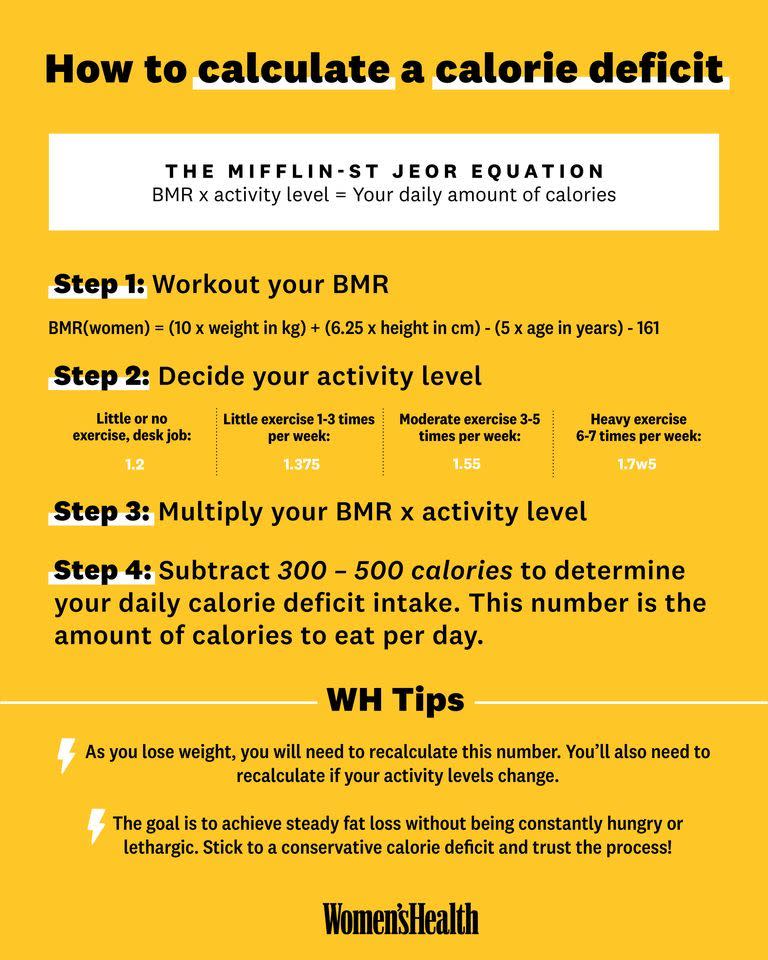
2. Eat more protein to help your muscles repair
Your muscles are made up of protein and the process of weightlifting breaks down your muscles’ natural protein structure, so you need more to trigger the repair response and encourage stronger, more robust muscle to grow back. Without it, you’ll likely feel weak and may suffer with DOMS (delayed onset muscle soreness), since you essentially make micro tears in your muscles during each workout and protein is what sews them back together.
I can’t say I suffered with DOMS in the aches and pains sense, but after week one, my muscles felt considerably heavier, so Fazakerley recommended I try tracking my protein intake on MyFitnessPal. Unsurprisingly, I wasn’t getting enough, and so I started to add 30g of Form Nutrition protein powder (the Chocolate Hazelnut Performance Blend is my fave) into my daily oats. By the end of week three, the heaviness had disappeared, and I started to feel stronger and more capable. What's more, Form's protein is genuinely delicious, and unlike a lot of protein powders, has no grainy texture whatsoever.
Performance Protein
I'm also a big fan of Natural Fitness Food's protein. The brand is stocked at Third Space (they have a small cafe area in the Soho branch), and I'd often treat myself to a shake post-workout.
Fazakerley advises aiming to consume 2 grams of protein per kilo of bodyweight per day.
3. Consider supplementing
Creatine is one of the most-researched fitness supplements on the market. And practically all of that research is positive: after an analysis of several existing studies on creatine, the International Society of Sports Nutrition (ISSN) declared that 'creatine monohydrate is the most effective ergogenic nutritional supplement currently available to athletes with the intent of increasing high-intensity exercise capacity and lean body mass during training.'
Creatine has also been proven to help build muscle mass and improve strength. 95% of it is stored in your muscles and, as well as support for your ATP energy system (meaning you’re capable of carrying out more intense workouts and lifting heavier), creatine has been shown to promote muscle gain by drawing water into the muscle, increasing levels of a hormone called IGF-1 (which increases muscle growth) and improving your performance ability and recovery. This has been so well proven that the European Food Safety Authority (EFSA) now recommends creatine supplementation alongside strength training for improving muscle growth in adults over the age of 55.
My results
On my last session with Fazakerley, I had my second and final body scan, which showed I'd gained a small amount of weight through muscle (and lost a little amount of body fat). The numbers weren't significant, but there were other monumental changes I'd noticed. Changes that, in my opinion, hold more weight (see what I did there?). My confidence, for one, was on another level. Everyone waxes lyrical about the sense of accomplishment weightlifting provides, and I can wholeheartedly vouch for that - even being able to lift a barbell (without any weight plates) made me feel like a #boss.
Then there was the effect it had on my sleep. As mentioned, I've never had any trouble getting eight hours kip a night, but ever since lifting heavier my sleep has felt infinitely deeper and I've woken up a new woman. Before, I'd occasionally wake up once or twice (usually to use the bathroom) during the night.
Weightlifting has also transformed my posture. The #WFH life has done my hunchback no favours, but lifting weights - particularly in upper body workouts - has helped me establish more of a mind-muscle connection with my shoulders and back, so I'm more aware of when I'm rounding or slouching. This benefit has been a big'un, and both my boyfriend and mum have commented on how different I look.
Last but by no means least, though it's only been six weeks, I've not felt a single niggle, ache or pain. As someone super prone to injury (in the last four years I've suffered a pelvic stress fracture from running too often and hamstring tendinitis from over stretching during yoga, amongst other smaller issues), this is a huge win. Studies show that strength training can be an effective way to prevent both acute and overuse sport injuries since the muscles surrounding your joints and bones are stronger and more able to protect them, but besides the fact that weightlifting gives me the capacity to continue with yoga and running without suffering, I've found a form of injury-free exercise that I adore.
Will I continue with it? You bet I will. I can't thank Fazakerley enough for showing me the ropes, and I now feel equipped to go forward and progress on my own. I hope this article helps you do the same.
An example lower body weightlifting workout
5-min mobility warm-up: bodyweight squats, hip flexor stretches, lunges with world’s greatest stretch
Superset: 12x Romanian deadlifts
12x hip thrusts
Repeat 3 timesSuperset: 20x alternate walking lunges (10 forward, 10 back)
12x goblet squats
Repeat 3 timesSuperset: 12x kettlebell swings
12x back extensions
Repeat 3 times
An example upper body weightlifting workout
5-min mobility warm-up: windmills, lateral neck stretches, cat-cows, eagle stretch
3x20 Incline press-ups
3x20 Tricep dips with straight legs
3x20 Dumbbell bent-over rows (each side)
3x20 Dumbbell bench press
More fitness challenges to inspire your next workout...
Walking challenge: Walk for 30 minutes a day for a month and see what happens
'I'm overweight and unfit, here's how I tackled the 75 Hard challenge'
'I did nothing but barre for a month, here's how it changed my body'
Cut through the noise and get practical, expert advice, home workouts, easy nutrition and more direct to your inbox. Sign up to the WOMEN'S HEALTH NEWSLETTER
You Might Also Like













